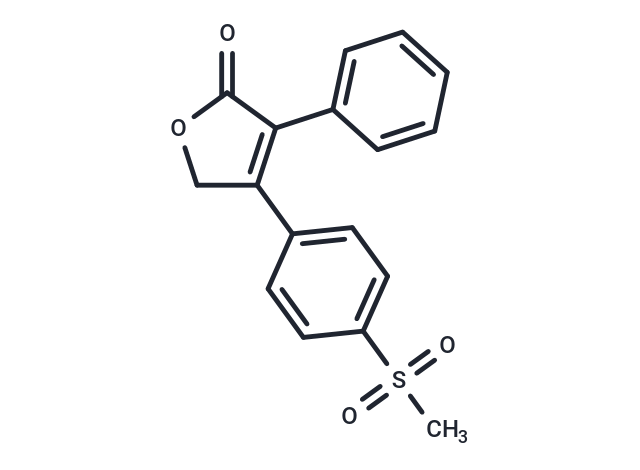Shopping Cart
- Remove All
 Your shopping cart is currently empty
Your shopping cart is currently empty

Rofecoxib (MK 966) binds to and inhibits the enzyme cyclooxygenase-2 (COX-2), resulting in an inhibition of the conversion of arachidonic acid to prostaglandins. Rofecoxib is a synthetic, nonsteroidal derivative of phenyl-furanone with anti-inflammatory, antipyretic and analgesic properties and potential antineoplastic properties. COX-related metabolic pathways may represent key regulators of cell proliferation and neo-angiogenesis. Some epithelial tumor cell types overexpress pro-angiogenic COX-2.

| Pack Size | Price | Availability | Quantity |
|---|---|---|---|
| 50 mg | $38 | In Stock | |
| 100 mg | $50 | In Stock | |
| 200 mg | $62 | In Stock | |
| 1 mL x 10 mM (in DMSO) | $50 | In Stock |
| Description | Rofecoxib (MK 966) binds to and inhibits the enzyme cyclooxygenase-2 (COX-2), resulting in an inhibition of the conversion of arachidonic acid to prostaglandins. Rofecoxib is a synthetic, nonsteroidal derivative of phenyl-furanone with anti-inflammatory, antipyretic and analgesic properties and potential antineoplastic properties. COX-related metabolic pathways may represent key regulators of cell proliferation and neo-angiogenesis. Some epithelial tumor cell types overexpress pro-angiogenic COX-2. |
| Targets&IC50 | COX-2:18 nM |
| In vitro | Rofecoxib inhibits the COX-2-dependent production of PGE2 in human osteosarcoma cells with an IC50 of 26 nM. Rofecoxib is a time-dependent inhibitor of purified human recombinant COX-2 with an IC50 of 0.34 μM. Rofecoxib causes inhibition of purified human COX-1 in a non-time-dependent manner. In a human whole blood assay, Rofecoxib selectively inhibits lipopolysaccharide-induced, COX-2-derived PGE2 synthesis with an IC50 value of 0.53 μM compared with an IC50 value of 18.8 μM for the inhibition of COX-1-derived thromboxane B2 synthesis after blood coagulation. [1] Rofecoxib moderately inhibits phenacetin O-deethylation with an IC50 of 23 μM. And a 30-minute preincubation with microsomes and NADPH considerably increases the inhibitory effect of Rofecoxib with an IC50 of 4.2 μM. Inactivation of CYP1A2 by rofecoxib requires NADPH, and is characterized by a K i of 4.8 μM. [2] |
| In vivo | Rofecoxib potently inhibits carrageenan-induced paw edema, carrageenan-induced paw hyperalgesia, and lipopolysaccharide-induced pyresis with IC50 values of 1.5 mg/kg, 1.0 mg/kg, and 0.24 mg/kg, respectively. It also blocks adjuvant-induced arthritis (IC50 = 0.74 mg/kg/day) and protects cartilage and bone in rats. [1] Oral administration decreases portal pressure in CCl4-treated rats, reduces activated HSCs, and downregulates hepatic levels of collagen, laminin, VEGF, and CTGF. [3] |
| Kinase Assay | In vitro biochemical and pharmacological assaysinhibition studies with recombinant human COX-1 and COX-2: Microsomal preparations of recombinant human COX-1 and COX-2 are prepared from a vaccinia virus-COS-7 cell expression system. Recombinant human COX-1 and COX-2 are expressed in baculovirus-Sf9 cells, and enzymes are purified. Enzymatic activity is monitored continuously by either a fluorescence assay measuring the appearance of the oxidized form of the reducing agent cosubstrate homovanillic acid or by oxygen consumption. The HPLC assay for the assessment of inhibition of purified COX-1 by Rofecoxib with 0.1 μM arachidonic acid substrate concentration, the determination of the stoichiometry of the complex between COX-2 and Rofecoxib, the dissociation rate constant of the enzyme-inhibitor complex by recovery of enzymatic activity, and the recovery of intact Rofecoxib from that complex are all performed as described previously. The solvent system for the HPLC analysis of Rofecoxib is 15:85 MeOH/aqueous potassium phosphate (1 g/liter), with elution by a linear gradient of 15 to 75% MeOH over 25 minutes with detection at 275 nm on a Novapak C18 column. |
| Cell Research | The human osteosarcoma cell line has been shown to selectively express COX-2 by reverse transcription-polymerase chain reaction and immunoblot analysis, whereas undifferentiated human lymphoma U937 cells selectively express COX-1. The production of PGE2 by these cells after arachidonic acid challenge is used as an index of cellular COX-2 and COX-1 activity, respectively. Rofecoxib is preincubated for 5 to 15 minutes with the cells under serum-free conditions [Hanks' balanced salt solution (HBSS)] before a 10-minutes stimulation with 10 μM arachidonic acid and measurement of PGE2 production. COX activity in each cell line is defined as the difference in PGE2 concentrations in samples incubated in the presence or absence of arachidonic acid.(Only for Reference) |
| Alias | MK-0966, MK 966 |
| Molecular Weight | 314.36 |
| Formula | C17H14O4S |
| Cas No. | 162011-90-7 |
| Smiles | O=C1C(=C(CO1)C2=CC=C(S(C)(=O)=O)C=C2)C3=CC=CC=C3 |
| Relative Density. | 1.333 g/cm3 |
| Storage | Powder: -20°C for 3 years | In solvent: -80°C for 1 year | Shipping with blue ice/Shipping at ambient temperature. | |||||||||||||||||||||||||||||||||||
| Solubility Information | DMSO: 50 mg/mL (159.05 mM), Sonication is recommended. Ethanol: < 1 mg/mL (insoluble or slightly soluble) H2O: < 1 mg/mL (insoluble or slightly soluble) | |||||||||||||||||||||||||||||||||||
Solution Preparation Table | ||||||||||||||||||||||||||||||||||||
DMSO
| ||||||||||||||||||||||||||||||||||||

Copyright © 2015-2025 TargetMol Chemicals Inc. All Rights Reserved.